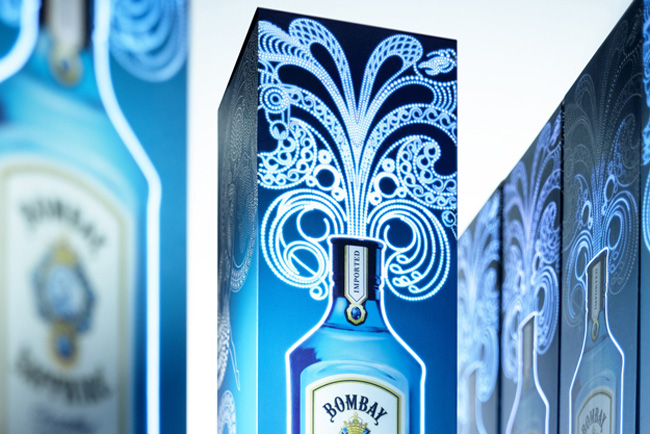Redacción Alabrent
“Thanks to impressive print packaging, brands can seduce customers into a change of purchasing vote at the point of purchase,” says Superbrands founder Marcel Knobil. “We would end up with less brand and more bland were it not for the attention that the packaging attracts.” Superbrands is acclaimed worldwide as being an independent authority and arbiter of branding excellence, committed to paying tribute to exceptional brands and promoting the discipline of branding.The impact of a winning combination of text and graphics extends way beyond fronting up that initial beauty parade. As well as being the ‘eye candy’ that hooks the consumer in the first instance, a perfectly reproduced external image provides consumers with an often subliminal product recognition and reassurance that can be the brand owner’s banker in a congested retail space.
Today’s packaging trends are driven by longer supermarket opening hours, continually enhanced print technologies and capabilities and demand to protect brands and increase recognition. Not only surviving but attaining the status as the preferred choice under such highly testing conditions is one half of the brand owner’s greatest challenge. The other is to meet it at an affordable cost.
Controlling quality
With the high probability of colour variations occurring not only between different substrates, but also print processes - and indeed from one printer to another, not only in different locations but even when they are running presses made by the same manufacturer - maintaining consistency can be a complex undertaking.
The best way to meet it is to ensure that all the contributory links within the supply chain which are engaged in steering the progress of a printed pack from hatch to despatch are all able to interact via an open entry web-based platform.
“Our vision is to connect the supply chain from the brand owner to the retailer and to make that flow broader and richer,” says Jef Stoffels, Esko Marketing Director.
“We do this by adding greater functionality which meets the go-to-market and quality needs of CPG (consumer packaged goods) businesses and retailers. We also make it possible for the brand owner to ensure that the flow of data is secure and transparent, mistakes and errors can be picked up early or avoided altogether and the net result is to get products to market faster.”
Similarly web-based colour management systems can extend the same degree of comfort and control to brand owners over how pre-determined colour parameters are then replicated accurately irrespective of substrate or supplier, ensuring a guaranteed consistency of colour reproduction that underpins brand authenticity and integrity. The X-Rite PantoneLIVE colour management solution is ideal for the brand owner as it has control over the pre-determined colour parameters, these are then stored in the cloud for use as and when required by his supply chain. This ensures accurate replications of the accredited brand image irrespective of substrate or supplier.
Pressed to perform
Converters equipped with smarter production facilities can be more directly instrumental in achieving cost and performance benefits to brand owners. Using high-definition flexo plate and software technologies, it is now possible to meet the requirements of 85% of current flexo-printed, flexible packaging without detriment to the finished result from CMYK + white rather than using special inks.
“Working out of a reduced colour palette means there are less plates and less waste ink. It ticks a lot of boxes,” says Ultimate Packaging (UK) Sales Director, Chris Tonge. “Whilst global players like Unilever and P&G have been specifying these solutions for the past 10 to 15 years, smaller brands are realising there is a cost advantage in that you can control the colours a lot better if you set the right standards.”
It’s not just improvement at the front-end that is raising quality and performance standards in flexo, still the sector’s most widely used print process accounting for over 40% of a current global printed packaging market worth around an estimated €250bn per annum, particularly for flexibles and corrugated board applications. Speed on the press and consistency across substrates are key. Ultimate Packaging has recently installed two additional servo-driven Bobst flexo presses ahead of drupa. Offset has also responded positively to deliver cost-efficient shorter run-lengths, for example Heidelberg’s Speedmaster Prinect Inpress Control inline automated turbo charged system which can change plates between jobs within ten minutes.
Digital mindset
What has sparked these improvements in analogue press technology is the increasingly potent challenge posed by digital print; not least in meeting brand owner requirements for cost-efficient shorter run lengths – and thereby, lower inventory levels – and the ability to differentiate products on-shelf through customisation. Whilst affordably utilising variable data has always been part and parcel of the digital print proposition, it’s now clearly on the retail marketing radar following its successful adoption by high-profile retail marketing campaigns run by Coca Cola, Heineken, Nutella and a steadily growing band of global blue-chip brands. “To take our brand off the packaging and replace it with something other than the Coca Cola script wasn’t easy to do within a structure like ours, where we operate according to very tight brand guidelines to protecting it,” says Coca Cola Packaging Innovator Greg Bentley. “The digital print capability enabled it to happen, but the marketing campaign is the really smart thing.”
“The combination of technological muscle and marketing inspiration is what it takes to make customisation fly,” says Paul Randall, HP Worldwide Brands Business Development Manager.
“It’s breaking away from the mindset of packaging being the static bearer of logos and ingredients tables and using it as a media opportunity for consumer engagement to the benefit of the brand. The media landscape has changed. It is becoming increasingly fragmented between above the line spend (bought media), PR and below the line (earned media), and packaging (owned media) – with the latter two increasingly linked together. Not surprisingly, brand owners are now regular visitors to HP’s Graphics Experience Centre in Barcelona.”
Likewise Xeikon’s technology centre in Antwerp. “For brand owners attending our Xeikon Café programme, it’s a two-track learning curve,” says Labels & Packaging Marketing Director, Filip Weymans. “First, understanding how the benefits of digital production can be translated into diversifying communication towards the audience they’re reaching out to and second, how the technology can address needs within their business model - notably, being faster to market and making better use of working capital.”
“While the adoption of digital is an accelerating trend, despite the buzz being created it’s still under-selling its potential,” says SAB Miller Global Packaging Manager, Doug Hutt. “The top ten brand owners in the world are generating over a quarter of a trillion dollars in sales. If just 10 - 20% of these were digitised with the balance going to analogue, that is still a very large potential revenue that converters haven’t yet grasped.”
“FMCG companies should be more proactive in going out and talking to the packaging industry – and the packaging industry should be addressing those issues and coming up with solutions,” says Doug Hutt, SAB Miller Global Packaging Manager.
Meanwhile, faster-running inkjet technology looks poised to dictate the next chapter in the digital packaging print story, not least via the keenly anticipated commercialisation of digital guru Benny Landa’s ‘nanographic’ presses engineered to deliver variable data printed material at offset speeds.
The finishing touch
Customisation is not the only route to catching the consumer’s eye on-shelf. Short-run, cost-effective special effects such as high gloss, glitter, metallic without recourse to hot-foil stamping and even Braille are also within the remit of next-generation digital post-press enhancement technology now establishing itself within the finishing sector. Also providing a more cost-effective means of achieving greater stand-out is the take-up of cold foiling using the analogue process - notably as an alternative to laminated / metallised substrates for labels and cartons.
Meanwhile, at the higher end of the scale is the arresting 3D effect achieved through the use of Fresnel lens technology providing instant ‘stand-out’ in retail duty-free for cartons containing the global gin brand Bombay Sapphire. “It’s obviously more expensive than a normal foil by about one-third, but you do get significantly greater impact. If you want something that is undeniably eye-catching and alluring then that’s what it takes,” says Dominic Burke, Webb deVlam UK Managing Director.
The new frontier
“The adoption of online-oriented technologies is pointing the way towards next generation applications aimed at facilitating greater engagement between brand and consumer,” says Sun Branding Solutions Packaging Technology Director, Gillian Garside-Wight. “Who would have thought that the Apple watch would be available five years ago? Brand owners need to deliver what consumers want including smarter packs that integrate with a digitally driven smarter life-style.”
Quite a number of applications on the market bring into play mobile technology. For example, on-pack augmented reality (AR) applications pioneered by Blippar that allow users to simply look at an object through the camera on their smartphone to activate an instantaneous digital search and draw down information from the web. In a recent campaign for Perrier, the invitation to consumers to shake their phone like a cocktail shaker to reveal a recipe was a typically innovative way to highlight the overall concept and add fun by using the technology to unique advantage.
Rather than position an icon on-pack to facilitate interaction, UK-based prepress specialist Reproflex3’s proprietary ‘PackLinc’ scanning technology embeds a hidden code within the ink itself, enabling the consumer to effectively treat the entire pack as a portal. Most recently applied within a limited edition run of the children’s POM-BEAR crisp packet, the system was the recipient of EFIA (European Flexographic Industry Association) and the prestigious Starpack gold awards last year. Debbie Waldron-Hoines, EFIA Director says, “Brand owners need a deeper understanding of the processes so that they can help make considered decisions on what is best suited for their brand. Both flexo and digital can work wonderfully together to enhance the brand.”
Underpinning product security and thereby underpinning brand integrity is another obvious avenue being explored by smart technologies. A fully printed near-field communication sensor tag (NFC) developed by Thin Film Electronics for Diageo’s Johnnie Walker whisky doubles as a security and anti-counterfeiting device as well as interacting with smartphones to dispense product advice and information.
As a lot of the labelling and pre-printed information currently required to be displayed on-pack is gradually phased out, just imagine the potential for branding afforded by that freed-up real estate. Brands are currently getting maybe only 40% of the pack’s surface for its primary purpose. However, if one small interactive barcode resolves all the regulatory and legal requirements 90% of the print surface could be released for marketing the product.
“Ironically, the most practical bridge linking brand and consumer might simply entail upgrading the humble linear barcode into a 2D format,” says Domino Printing Sciences Global Account Manager, Craig Stobie. “Brand owners are yet to fully realise the potential in having a machine-readable code that not only contains a lot more data but with the same footprint or smaller than a human-readable, but can also actually be cheaper.”
“Whether it be products that communicate with your tablet or temperature or time sensitive thermochromic inks that indicate when your lager is perfectly chilled or provide the re-assurance that pre-packaged meat is safe to eat, the facility for interactivity ticks all the right boxes for forward-looking brand owners,” says Eef de Ferrante, Managing Director of the Active & Intelligent Packaging Industry Association (AIPIA).
“Brand owners need to meet the challenges faced by counterfeiting, product security in the supply chain, consumer engagement and ‘Big Data’ management. Brand protection and better marketing of their products are major starting points towards averting potential reputational damage and simply saving money.”
Eye-catching and innovative printed packaging is a shrewd investment towards building a loyal and enduring customer-base, concludes Des King. Whilst consumers are exercising greater versatility than ever before in choosing how and where they are able to gather information through which to determine product preferences, packaging offers the brand owner a uniquely guaranteed opportunity to control how they communicate with prospective customers face to face in-store at the very point of purchase. No surprise then that the ways in which the package is printed will occupy centre-stage at drupa 2016.



